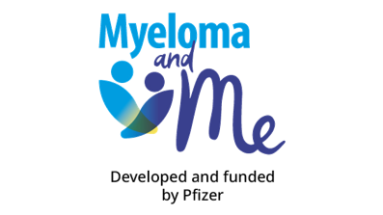Multiple myeloma-related fatigue: What can cause it and how to manage it
The information provided is for educational purposes only and is not intended to replace discussions with a healthcare provider.
1. What is multiple myeloma-related fatigue?
People living with multiple myeloma can often feel very tired or not have the energy to do normal day-to-day activities. They may also feel more confused than normal, struggle to think clearly, and may not feel better even if they get more rest or sleep. This is called fatigue, and it’s a common symptom that most people with multiple myeloma experience.1,2
2. What can cause multiple myeloma-related fatigue?
Multiple myeloma-related fatigue can be caused or made worse by different things, but one of the main causes is anaemia.2
Anaemia means that you have a lower number of red blood cells in your blood than normal. This is because myeloma cells interfere with the blood-producing activities of bone marrow, causing a shortage of healthy red blood cells.3 Because red blood cells move oxygen around the body, having a lower number of red blood cells means that some parts of your body aren’t getting enough oxygen. This can make you feel tired or weak.2
Another cause of myeloma-related fatigue is when the kidneys don’t work as well as they should due to myeloma or its treatment. The kidneys make an important hormone called erythropoietin, which tells the body to make red blood cells. If the kidneys are not working properly, they make lower amounts of erythropoietin than normal, which in turn means that a lower number of red blood cells are made. The kidneys also control the amount of fluid and salts in the body and filter the blood to keep it clean. If the kidneys aren’t working well, waste substances aren’t removed from the blood, and this can make you feel unwell.2
People living with myeloma may also have too much calcium in their blood – this is called hypercalcemia. Having hypercalcemia can cause symptoms that are like those caused by fatigue, such as confusion, a lack of energy, and muscle weakness.2 Hypercalcemia can also cause more serious issues with your kidneys or heart.4
Inflammation may also cause fatigue in people living with cancer.5 Inflammation is the body’s normal response to injury or infection; however, if the inflammation lasts for a long time, it can cause fatigue.6 Cytokines are a type of protein that can cause inflammation, and someone living with myeloma may have more cytokines in their blood than normal.7 Having more cytokines in your blood than normal may also mean you have more C-reactive protein, which is a protein that has been linked to cancer-related fatigue in people living with myeloma.8,9 You can talk to your healthcare team to find out how much inflammation you have in your body and ways that it can be reduced, if they think that this is needed.
Some of the treatments for multiple myeloma may also cause fatigue.2 When starting a new treatment, it’s important to discuss what the common side effects of the treatment could be. Steroids are a type of drug that cause muscle weakness and may make it more difficult to sleep; they are often given to people living with myeloma.10 Talk to your healthcare team if you think you have fatigue, or if your fatigue gets worse.
3. Ways to help manage your fatigue
Food and diet
- Getting good nutrition from food is an important part of keeping the body healthy. This means including a good balance of protein, fibre, healthy fat, vitamins, and minerals.11 Speak to your healthcare team to discuss your individual needs. For some people, a doctor may prescribe vitamins or other supplements to help reduce fatigue12,13
- Drinking plenty of water can help to reduce fatigue, as being dehydrated can sometimes make fatigue worse. Most people need to drink 8 to 12 cups of fluids each day.
- If you sweat a lot during the day, you may need to drink more than this. Fluids and foods that are good for hydration include water, juices, broth, ice lollies, and gelatin.11 Make sure you discuss any personal dietary or hydration regimens with your healthcare team
Exercise and activities
- Since having multiple myeloma can cause damage to bones,2 it is important to talk to a doctor before beginning any new exercises or activities so that they can discuss any possible risks. They may also provide a referral to an exercise specialist who can put together a personalised exercise plan for you2,11
- Physical activity and exercise can help with fatigue.2 A lack of physical activity can make you feel very tired and less able to sleep. It can also make someone feel more frustrated or “low”, especially if they used to be very active2
- Yoga may help to improve energy levels for some people living with myeloma2
- Massage therapy may also be relaxing and help to relieve pain. However, not all massage therapies are suitable for people who are having myeloma treatment or have bone damage, so it’s good to check this with your healthcare team14,15
4. How to talk to doctors about fatigue
Fatigue can be difficult for doctors to recognise, as there isn’t a test to measure it. Instead, doctors rely on how someone describes their fatigue to them. The questions below might help someone to accurately describe their fatigue to a doctor16:
- When did the fatigue first start?
- When did you first notice that this fatigue was worse than fatigue you’ve had before?
- How long has it lasted?
- Does anything make it better? Worse?
- Are there times of the day when you notice it more?
- How has the fatigue affected the things you do every day or the activities that give meaning and enjoyment to your life?
References
- National Comprehensive Cancer Network. Multiple Myeloma. NCCN Guidelines for Patients. Available here. Accessed 31 March 2023.
- Myeloma UK. Fatigue and myeloma – Symptoms and complications Info guide. Available here. Accessed 31 March 2023.
- International Myeloma Foundation. Multiple Myeloma and Anemia. Available here. Accessed 31 March, 2023.
- Carroll MF, et al. A Practical Approach to Hypercalcemia. Am Fam Physician. 2003;67:1959-1966.
- Bower J. Cancer-related fatigue: Mechanisms, risk factors, and treatments. Nat Rev Clin Oncol. 2014;11(10):597-609.
- Cleveland Clinic. Inflammation. Available here. Accessed 31 March, 2023.
- Robak P, et al. Cytokine and chemokine profile in patients with multiple myeloma treated with bortezomib. Mediators Inflamm. 2020;2020:1835836.
- Yang J, et al. Human C-reactive protein binds activating Fcgamma receptors and protects myeloma tumor cells from apoptosis. Cancer Cell. 2007;12(3):252-65
- Booker R, et al.. The relationships among physiologic variables, quality of life, and fatigue in patients with multiple myeloma. Oncol Nurs Forum. 2009;36(2):209-216.
- Myeloma Australia. Fatigue and Myeloma. Available here. Accessed 31 March 2023.
- Myeloma UK. Diet and nutrition in myeloma. Available here. Accessed 31 March 2023.
- American Cancer Society. Drug Therapy for Multiple Myeloma. Available here. Accessed 31 March 2023.
- WebMD. Vitamins and Supplements for Multiple Myeloma. Available here. Accessed 31 March 2023.
- Myeloma Canada. Complementary Therapies. Available here. Accessed 31 March 2023.*
- Cancer Research UK. Massage Therapy. Available here. Accessed 4 April 2023.
- Cancer Research UK. How is fatigue assessed. Available here. Accessed 4 April 2023.
PP-UNP-GBR-4431. April 2023










